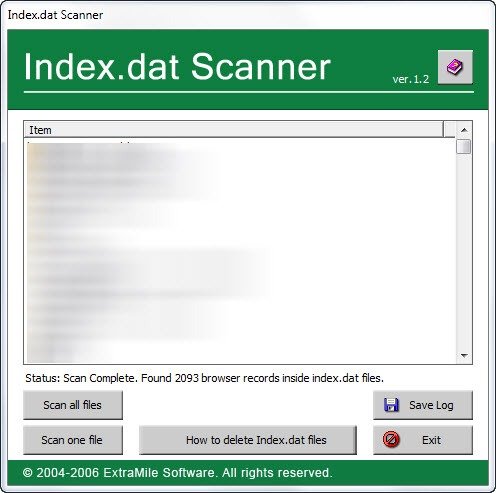Index.dat files are files hidden on your Windows computer, that contain details of all of the websites that you have ever visited. In Windows 7 and earlier, Internet Explorer 9 and earlier, used the index.dat file to index all this information, including the Internet Cache, Cookies and History. Every URL and every Web page is listed there was indexed. Not only that, but all of the emails sent or received through Outlook or Outlook Express also get logged in these index.dat files. These files were to be found therefore in the Internet Cache, Cookies and History folders.

What is Index.dat file
However, things changed with Windows 11/10/8. In Windows 11/10/8, Index.dat files are not used by Internet Explorer 10. The indexing functions are being implemented within a Microsoft database system. The WebCacheV01.dat file in the C:\Users\username\AppData\Local\Microsoft\Windows\WebCache folder in IE11 in Windows 11/10 is said to be playing a similar role. While you may be able to see index.dat files in some locations, you will also be able to see counters.dat file, container.dat file, suggestedsites.dat file and so on, in the Temporary Internet Files folder, History, and the Cookies folder. These too, are hidden files. I found most of them to be 0 size files on my Windows computer.
Where is the index.dat file located
Where is the index.dat file located in Windows 7/8? Index.dat are files hidden on your computer that contain all of the Web sites that you have ever visited. Every URL and every Web page is listed there. To access it, you will have to type in Explorers address bar the following location and click go:
C:\Users\<username>\AppData\Local\Microsoft\Windows\Temporary Internet Files\Content.IE5
Only then will you be able to see the index.dat file. Conclusion? The Content.IE5 folder is super hidden!
Index.dat file reader or viewer

You can use freeware Index.dat Suite or Index.dat Scanner to view the index.dat file in Windows 7 or earlier. But you will not be able to use these freeware on Windows 11/10/8, for reasons explained above.
Windows 7, Windows Vista users can download and use the 60KB freeware here. It promises to be quite a revealing experience!
Delete Index.dat file
Over a period of time, the Index.dat file in the History folder – and other folders too – could become very large. You cannot delete it or resize it using built-in options. Even if you clear the Internet Explorer History by clicking the Clear History button, the size of the Index.dat file will not change. Nor will changing the Days to keep pages in history value to 0 change its size. You will have to delete it.
To protect your privacy, you may wish to remove it, but its removal is difficult, and the manual removal procedure is tedious. You can instead use a good cleaner like freeware CCleaner to remove the file. After you delete or erase the index.dat file, Internet Explorer will create a new empty index.dat file on reboot.
Go here to find some interesting facts about Temporary Files.
Looking to learn more about other files or file types or file formats in Windows? Check these links:
Windows.edb files | Desktop.ini file | Thumbs.db files | DLL and OCX files | NFO and DIZ files | Swapfile.sys, Hiberfil.sys & Pagefile.sys | NTUSER.DAT file | Nvxdsync.exe.